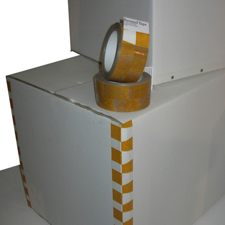Colour coded electrical tape
I was interested to hear this week that an artist in Sheffield who is working with LEDs has had some research done on how to give the strings of LEDs in her work more resilience as the work has to be publicly sited. The answer was to embed the LEDS in a heat shrinking transparent electrical tape. Tape seems to be going through a technical revolution, some of its more industrial uses now looking to replace older methods such as welding and riveting, thus making much cleaner finishes and in many cases a much better waterproof bond.
I have put up a post on drawing with tape before, but that was a few years ago and its use is perhaps even more popular as a drawing medium, so it is perhaps timely to remind you of how useful it can be, as well as how powerful and very particular the aesthetic language of tape drawing can be.
I have put up a post on drawing with tape before, but that was a few years ago and its use is perhaps even more popular as a drawing medium, so it is perhaps timely to remind you of how useful it can be, as well as how powerful and very particular the aesthetic language of tape drawing can be.
Mark Khaisman
I've been working with brown translucent packaging tape myself recently and it is a very sensitive medium if you want to control tonal variation. It has other benefits too, such as if you cut it neatly into rectangles, eventually all the small pieces of tape begin to create a grid like structure that gives stability to images that could be rather formless. Mark Khaisman's tape drawings are a useful indicator of the types of possible surfaces you can achieve and it is also useful to follow his career and look at how he has progressed his work from an aesthetic dependent on tape, to one now using more sculptural conventions.
Aakash Nihalani
Joy Walker has used tape to create tightly controlled rhythmic geometric structures. Walker is an artist living and working in Toronto. Her work reflects her interest in pattern, repetition, geometry and the ephemeral, using a variety of methods including printing, photography, drawing, stitching and cutting. In the image below you see her attaching a small, very informal tape drawing to a wall. Her approach to using tape is to reveal its delicate, more sensual properties.
Joy Walker
Maurizio Cattelan: Comedian 2019
Perhaps the Guerrilla Girls had the most succinct repost.
Find below a few more tapes that can be bought on line. The fact that tape can be thought of as very long drawings means that certain types of associations gravitate around this common commercial product, from miniature roads to playful games about measurement. The idea I really like, which is the screw head tape; a tape designed to stick two surfaces together but to make the join look as if it was a screw fixed joint, is a simple illusion, but in its very uselessness it becomes poetic. The same designers (Richard Shed and Sam Johnson) came up with Dovetail tape which is conceptually witty but not quite as poetic.
Centre Tape
Tape measure tape
Screw head tape
Dovetail tape
It's not just designers that have used tape in interesting ways, the architect Bijoy Jain of Studio Mumbai, has had to use tape to draw with because of trying to make drawings in a very wet climate.
Studio Mumbai: Saat Rasta: Mahindra Unit Tape drawing, 2013. Pencil and tape on wood
Bijoy Jain has this to say about his design process; 'The way I practice, architecture works both on a personal as well as universal level. If we think that what fundamentally makes me, also fundamentally makes everyone else, then it means that we are all deeply connected'.
Tape as a connecting material is something that is not too far away from the material that wrapped mummies in ancient Egypt, and of course before we forget, was also the stuff that Maurizio Cattelan used for his piece, 'A Perfect Day', the 1999 work in which he duct-taped his gallerist Massimo De Carlo to a wall.
'A Perfect Day'
















Wow, its really great blog. Thanks for an updating detailed information about this drawing with tape. Keep sharing more post with us.
ReplyDeleteelectrical fish tape
Made from weather-resistant plastic, barricade tape is lightweight, easy to deploy, and essential for public safety.
ReplyDeleteBarricade tape is a highly visible safety tool used to mark hazardous or restricted areas, ensuring public awareness and preventing unauthorized access. Often seen in construction zones, accident sites, or event spaces, this brightly colored tape is designed to catch attention quickly. Made from durable plastic, it can withstand outdoor conditions and is easy to install and remove Red Warning Tape in Gujarat communicates warnings effectively without the need for permanent signage, making it ideal for temporary situations. Its versatility and simplicity make it an essential item for safety management across various industries.
ReplyDeleteI can tell a lot of thought and effort went into this. It really shows in the quality.
ReplyDeleteboxes rim boxes
LDPE Film is a flexible, lightweight, and durable plastic solution widely used for packaging and protection. Crafted from low-density polyethylene, it offers excellent resistance to moisture, chemicals, and impact, making it ideal for wrapping food, industrial goods, and construction materials. Its clarity allows easy product identification, while its smooth texture ensures hassle-free handling. Whether used as liners, shrink wraps, or protective covers Shrink Film Manufacturers adapts effortlessly to various applications. Recyclable and cost-efficient, it combines practicality with sustainability, offering reliable performance in every roll for both industrial and commercial use.
ReplyDeletehi
ReplyDelete